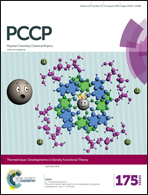Exploration of the presence of bulk-like water in AOT reverse micelles and water-in-oil nanodroplets: the role of charged interfaces, confinement size and properties of water†
Abstract
The properties of water in a confined environment can be drastically different than the bulk water. In a confined system, e.g. the interior of a reverse micelle, there exist at least two distinct regions namely “interfacial water” characterized by markedly slower dynamics, and “core water”, which may resemble bulk water for a larger size of the water pool. Using atomistic molecular dynamics simulations, we systematically investigate the presence of bulk-like water in AOT reverse micelles (RMs) with varying size given by w0 = [H2O]/[AOT] = 10, 15 and 20. In order to understand the effect of the negatively charged interface of the RM, we have performed control studies for the model systems of water-in-oil (isooctane) nanodroplets with the same size of the water pool as the RM systems. In order to quantify the deviations from bulk-like behavior, we have used three kinds of structural order parameters, namely (i) number density to probe the local translational ordering, (ii) tetrahedral order and hydrogen bond distribution to probe the local orientational ordering, and (iii) dipolar orientation relative to the radial vector to capture the global orientational ordering of the water dipoles. We demonstrate that the size of the “core water” region that resembles bulk water decreases in the above order, i.e. orientational order parameters of water molecules are perturbed by the charged interface to a larger length scale as compared to the translational order. We have compared the translational and rotational dynamics of the water molecules for the interfacial and core regions to find that the slower dynamics persists even for the core water for the size range that we have studied although to a much lesser extent as compared to the interfacial water. Moreover, we demonstrate that the hydrophobic interface in the water-in-oil nanodroplets has a much weaker effect on the structure and dynamics of the confined water molecules as compared to the anionic RMs. Thus, the major contribution towards the structural ordering and slow dynamics of water in a charged RM system would originate from the strong electrostatic and hydrogen bonded interactions with the interface, and not due to the spatial confinement effect.

- This article is part of the themed collection: New Frontiers in Indian Research

 Please wait while we load your content...
Please wait while we load your content...